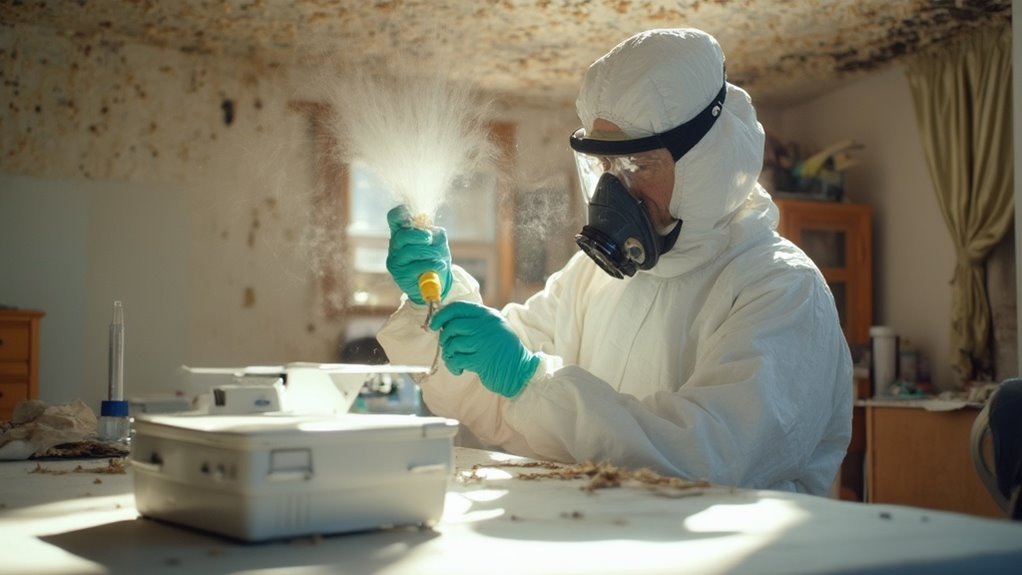Asbestos testing is vital for a healthier home, helping you identify hidden dangers that can impact your family's well-being. By detecting harmful asbestos fibers, you can take proactive steps to mitigate serious health risks, including lung cancer and mesothelioma, which may emerge decades after exposure. Regular testing prevents unexpected costs from remediation and guarantees compliance with local regulations, particularly in older homes. A certified inspector collects samples, and detailed lab analysis reveals the presence and concentration of asbestos. This knowledge empowers you to make knowledgeable choices, enhancing your home's safety and air quality. Investigate further to uncover more insights.
Understanding Asbestos and Risks

Understanding the risks associated with asbestos is vital for maintaining a healthier home. Asbestos refers to a group of six naturally occurring fibrous minerals, primarily categorized into two types: serpentine and amphibole. Serpentine fibers are long and flexible, while amphibole fibers are straight and stiff. These fibers possess remarkable durability and resistance to heat, chemicals, and fire, making them commercially valuable in products like insulation and roofing materials, particularly in homes built before the 1980s. Additionally, asbestos occurs in large deposits or as contaminants in other minerals, which can pose further risks if not properly managed. Moreover, asbestos regulations vary by location, and it's crucial to be aware of them during any renovation or repair work.
However, the health implications of asbestos exposure are severe. Inhaling asbestos fibers can lead to serious diseases such as lung cancer, mesothelioma, and asbestosis—conditions that may develop 20 to 50 years after initial exposure. The cumulative nature of exposure means that even minimal contact can increase the risk of developing asbestos-related diseases. Additionally, if you're a tobacco smoker, your risk for lung cancer skyrockets when combined with asbestos exposure.
Recognizing the types of asbestos and understanding their potential health risks is vital in safeguarding your home and health. Awareness is the first step toward making knowledgeable choices regarding asbestos management and testing.
Importance of Asbestos Testing
When it comes to maintaining a safe living environment, the significance of asbestos testing cannot be overstated. Identifying hidden asbestos risks is essential to preventing exposure and avoiding serious health complications, such as asbestosis, mesothelioma, and lung cancer. You need to protect not only yourself but as well your family, workers, and the general public from these hazardous materials.
Compliance with asbestos regulations is another important aspect of testing. It's mandatory during the demolition or renovation of older buildings, ensuring you meet legal requirements set by organizations like OSHA and EPA. This compliance helps you avoid costly fines and penalties while obtaining necessary permits for construction projects.
Moreover, asbestos testing can save you from unexpected financial burdens. By guiding remediation efforts and ensuring ecological health, it contributes to knowledgeable decision-making when purchasing or renovating properties. Additionally, early detection benefits of professional testing help prevent long-term exposure and associated health risks. Finally, knowing the results of professional testing provides peace of mind, reducing stress about potential health hazards and ensuring adherence to safety guidelines. Essentially, asbestos testing is not just a precaution; it's a fundamental step toward a healthier home and community.
Asbestos Testing Process

Asbestos testing is a systematic approach designed to identify and quantify the presence of asbestos in various materials within your home. This process begins with certified inspectors conducting sample collection from potential hot spots, such as insulation materials, tiles, and popcorn ceilings. It's essential to have trained professionals handle this task, as improper sampling can lead to unnecessary exposure to harmful fibers.
Once samples are collected, they undergo lab analysis using methods like Polarized Light Microscopy (PLM) and Transmission Electron Microscopy (TEM). PLM identifies asbestos by examining optical properties, while TEM provides higher magnification for finer fibers and detailed chemical composition. In a controlled lab environment, samples are prepared and analyzed meticulously to guarantee accurate results.
The lab produces thorough reports detailing the areas tested, types of asbestos found, and their percentage composition. This information is critical for effectively managing asbestos risks in your home. By understanding the asbestos testing process, you empower yourself to make educated choices about your living environment and take necessary actions to guarantee its safety.
Timing for Asbestos Testing
Timing for asbestos testing is vital, especially if you're planning renovation or demolition activities. Understanding the testing timeline can help you navigate asbestos regulations effectively and guarantee safety. Here are four key considerations to keep in mind:
- Schedule Testing Early: Aim to have testing done before any work begins to avoid disturbing materials that may contain asbestos.
- Consider Accessibility: Confirm that the areas needing testing are easily accessible for inspectors, as this can affect scheduling.
- Plan for Results: Laboratory analysis can take from 24 hours to a week; factor this into your project timeline to avoid delays.
- Prioritize Urgency: If you suspect damaged asbestos-containing materials, immediate testing is vital to prevent exposure.
Benefits of Regular Testing

Regular testing for asbestos is vital for maintaining a safe home environment and protecting your health. By routinely checking for asbestos, you can prevent the serious health risks associated with exposure, such as lung cancer and mesothelioma. Early detection allows you to take necessary precautions, safeguarding your family from the long-term effects of asbestos.
Furthermore, regular testing can lead to significant financial savings. Identifying asbestos before you start renovations helps avoid costly removals and potential legal issues. It guarantees that any necessary precautions are taken, preventing accidental release of toxic fibers, which could lead to expensive cleanup efforts later on.
In addition, routine testing improves your home's air quality, reducing the chance of harmful fibers becoming airborne. Compliance with local regulations is another advantage, as many states require testing before renovations or demolitions, especially for older homes.
Frequently Asked Questions
How Much Does Asbestos Testing Cost on Average?
On average, asbestos testing costs around $483, influenced by cost factors like property size, sample types, and testing methods. Larger areas or multiple samples will typically increase your overall testing expenses considerably.
Can I Test for Asbestos Myself?
You can use asbestos testing kits for DIY asbestos identification, but it's risky. Disturbing materials may release toxic fibers. Professional assessment guarantees safety and accuracy, making it the better choice for reliable results.
What Are the Signs of Asbestos in My Home?
Imagine a hidden specter lurking in your walls. If your home's older, check for popcorn ceilings, vinyl flooring, or damaged insulation; these asbestos identification methods reveal potential health risks that could threaten your family's well-being.
How Long Does Asbestos Testing Take?
Asbestos testing typically takes a few hours for sampling methods and a few days to a week for testing procedures. Factors like property size and lab availability can influence the overall duration of the process.
What Should I Do if Asbestos Is Found?
If you find asbestos, think of it as a ticking time bomb; investigate removal options immediately. Ignoring it heightens health risks. Consult certified professionals for safe assessment, containment, or removal to protect your environment.
